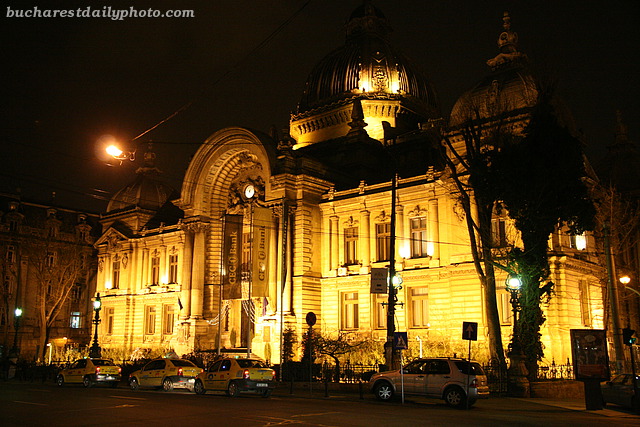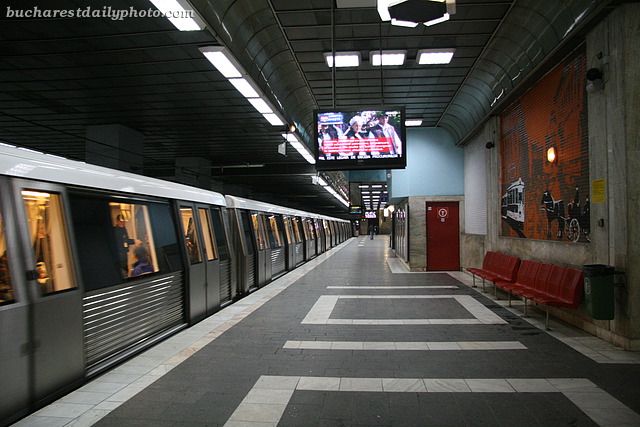Continuing with the between the war architecture series. Some time ago I confessed to be a fan of this type of architecture in all its flavours and shapes (Modernist, Cubist, Bauhaus, Art Deco). Bucharest has numerous examples of it throughout the city, many of them not in good shape due to lack of adequate maintenance. Despite this, one can still discern the elegant lines and the interesting architectural solutions that were adopted. The example in today’s photograph lies on Boulevard Lascăr Catargiu, an area which developed as an upscale residential neighbourhood around 1900. The building was built in 1934-1935 by architect Remus Iliescu.
Finally! The temperature is above zero. To be more exact my outside thermometer is registering 5 degrees Celsius at this moment (2PM). It’s the second time the temperature raised above zero in the last week (the other time it happened was on Tuesday). Snow’s melting and walking the sidewalks in the city center feels like being in the shower because of the water dripping from the roofs. Which is why the statues in today’s photographs look like they just took a bath.
Capşa House (Casa Capşa in Romanian), “Restaurant, Hotel, Café and Confectionery”, was for long period of time the symbol of the Romanian elite society, a meeting place for politicians, journalists, artists, writers, etc. It all started in 1852 when two brothers, Anton and Vasile Capşa, opened a confectionery shop on Calea Victoriei, a short distance from the present location of Capşa House, which was opened as a confectionery shop by their younger brother Grigore Capşa (1841-1902) in 1868. Grigore Capşa had just returned from Paris, where he apprenticed for four years at the renowned Maison Boissier. Soon, he established a solid reputation as a known brand all over the continent, becoming the supplier for the Royal Court of Romania in 1869 (until then the Royal House was bringing the confections from Paris). Serbian and Bulgarian courts followed in 1882 and 1908, respectively. In 1886 the hotel and the restaurant opened. The hotel was quickly recognized as the most elegant Romanian hotel, winning, together with the confectionery shop, lots of awards and distinctions. Finally, in 1891, the owners opened Capşa cafe, which became the center of the fashionable life in Bucharest. With so many members of the high society and politicians frequenting this place, it was said that governments were made and broke at Capşa. After 1930s the writers made the cafe their meeting place. The writer Tudor Arghezi made even a short portrait of the “writer who goes to Capşa”. He wrote “The Capşa man is an inteligent and dangerous individual and the real critique is done at Capşa, not in the literary press. If you’re stupid at Capşa is impossible to be smart anywhere else, even in writing”. The decline of the Capşa House came with the arrival of the communist regime, when it was run by the state under the name “Bucharest. Brasserie and restaurant”. After the fall of communism, Casa Capşa was restored quite beautifully in 2002-2003 and reopened as an elegant 5 star hotel. Unfortunately they didn’t succeed in giving back its spirit and glamour which can only be relived now in the history books.
I just realized it’s been some time since I posted a stencil graffiti, so I thought I have to remedy this situation. I think the image speaks for itself, no need to explain anything 🙂 I took this photo in the Old Center.
In a city that lately has become paralyzed by traffic, Bucharest’s subway or metro (Metroul Bucureşti in Romanian) is by far the most reliable form of public transport. Built in 1979, the metro is cheap, safe, and relatively clean. Unfortunately it doesn’t cover all parts of the city, although they are working on extending the network which at this moment has 4 lines and 49 stations. The city center however is in my opinion very well served with stations in most of the big squares. Trains run between 5.00 am and 11.30 pm; during peak hours they run at about 3-10 minutes, while off-peak (late at night and on Sundays) one has to wait more than 10 minutes. Tickets can be bought at the booths inside the stations; a ticket for 2 rides cost about $0.85 / €0.60 while a ticket for 10 rides costs about $2.70 / €1.96. There is also a one month pass which costs about $8.4 / €6. The metro can be crowded in the morning and in the afternoon hours when people commute to and from work but during the rest of the day is pretty empty. Metro stations are not very well signposted, but with the help of a map it’s not hard to get around. All trains have maps posted inside the wagons. Today’s photograph shows the Northern Train Station subway stop.
After showing you the photo of the she wolf braving the snow, here comes another animal, this time a mythical one. Now this golden dragon really seems to be jumping with joy at the sight of the snow. The dragon was guarding the entrance of a Chinese restaurant named – how else – “The Golden Dragon”. The restaurant is now closed and the building that housed it is up for sale, but the dragon’s still there.
Last October I’ve told you the story of the well-traveled she wolf. Here is a new shot of the she wolf enjoying the snowfall.
It’s snowing heavily outside. There’s already a lot of snow on the ground and it’s been announced that schools will be closed tomorrow. For these reasons I decided to post a photo taken last November to remind us of a sunny time when everything was not colored in white. Not to talk about the fact that this decision spares me from going outside 🙂 So here it is for you to admire another addition to the reflection series. The apartment building that’s the subject of the reflection was built in 1936 by architect Nicolae Cucu.
In the cellar of the Museum of Romanian Peasant there are two small rooms dedicated to the “collectivization” of agriculture in Romania which took place in the early years of the communist regime. Started in 1949 the project sought to force the peasants to bring their land into collective farms. Aside from the persistent propaganda, violent means like intimidation, beating, arrest and imprisonment were used to convince peasants to join. According to the wikipedia article, by 1962 a total of 96% of the country’s arable surface and 93.4% of its agricultural land had been included in collective structures. To achieve this 80.000 peasants were taken to court, 30.000 of which were judged and found guilty in public trials. The effect of the small rooms is rather chilling. The first room is wallpapered with old newspapers clippings while the second room looks like one used for a party meeting, where “traitors” were brought forward, accused and asked to self-criticize. In the photo you can see the entrance to the first room where one corner is occupied with a collection of busts from that era.









